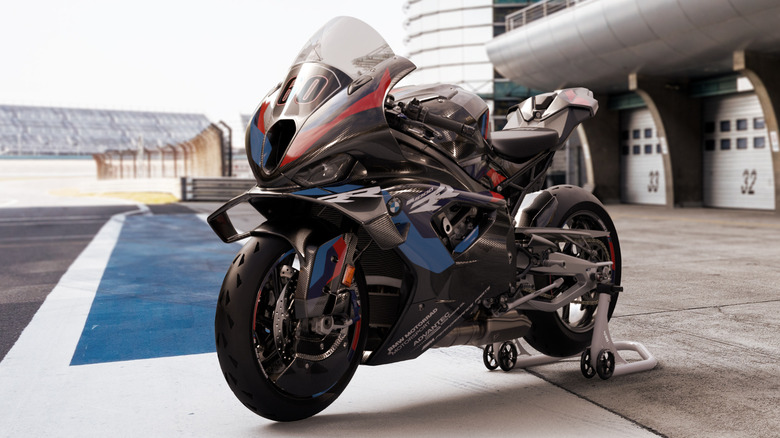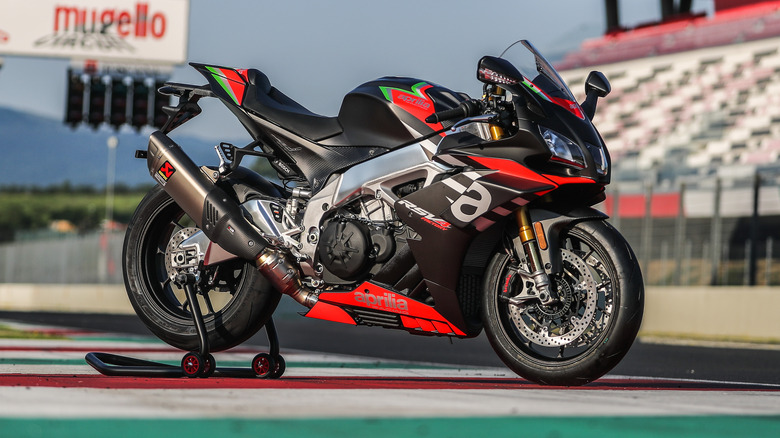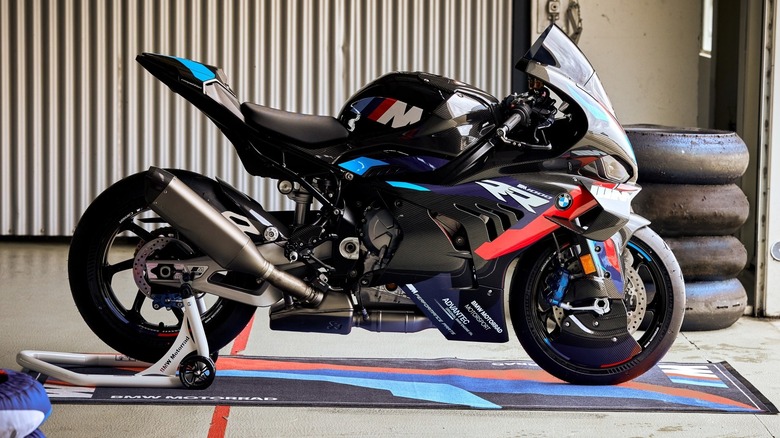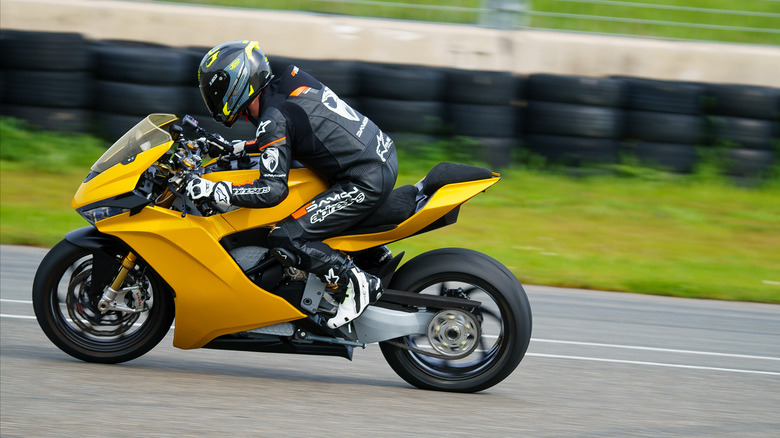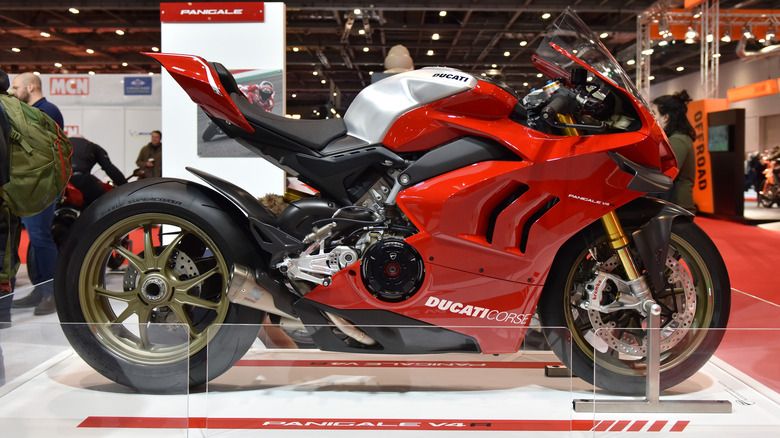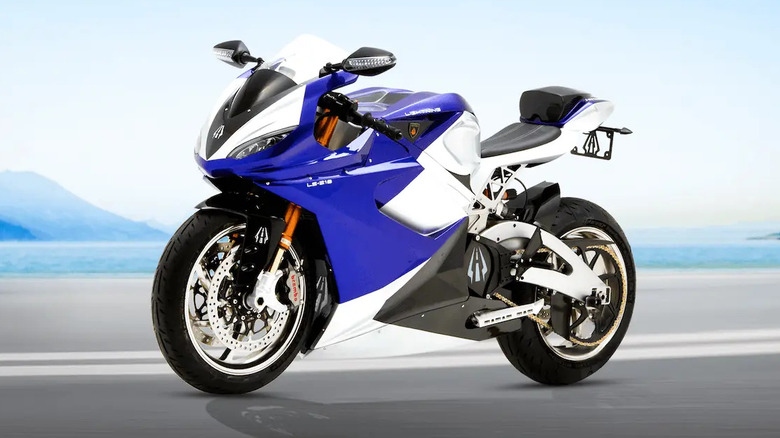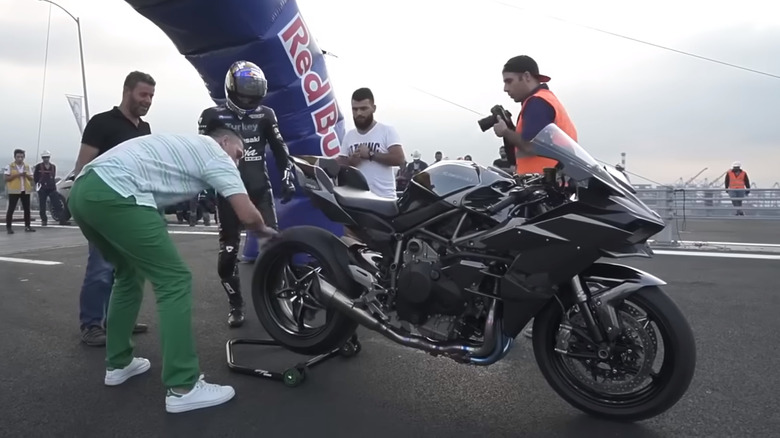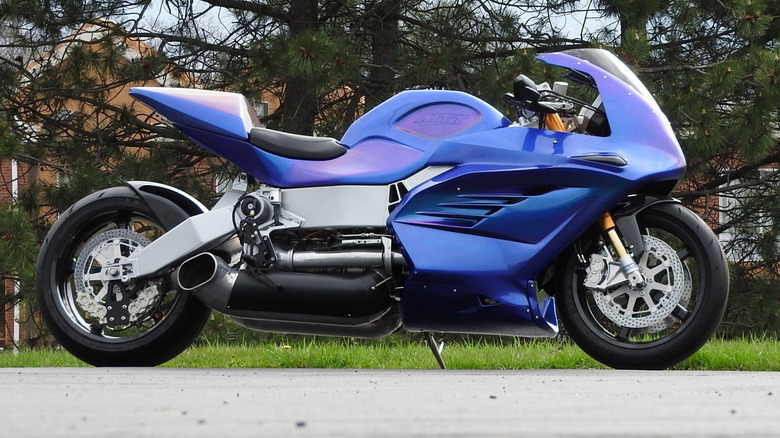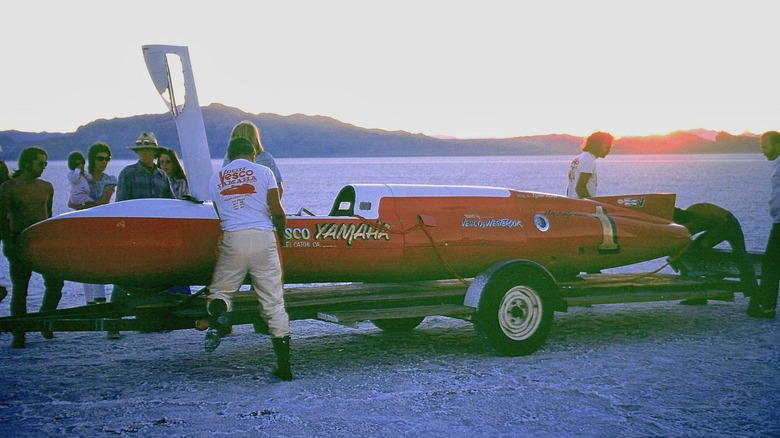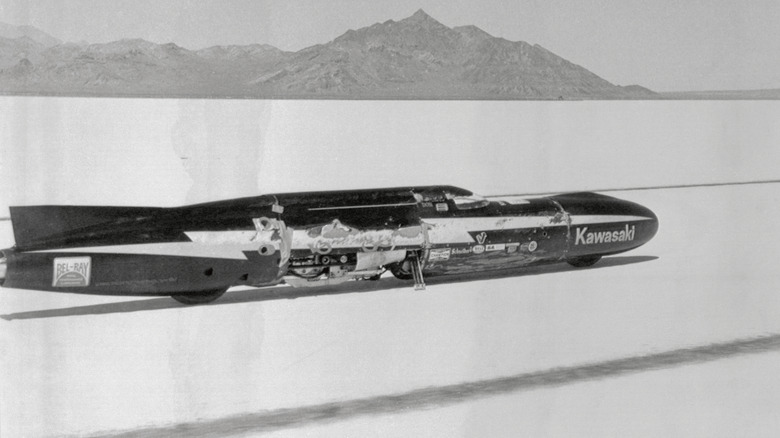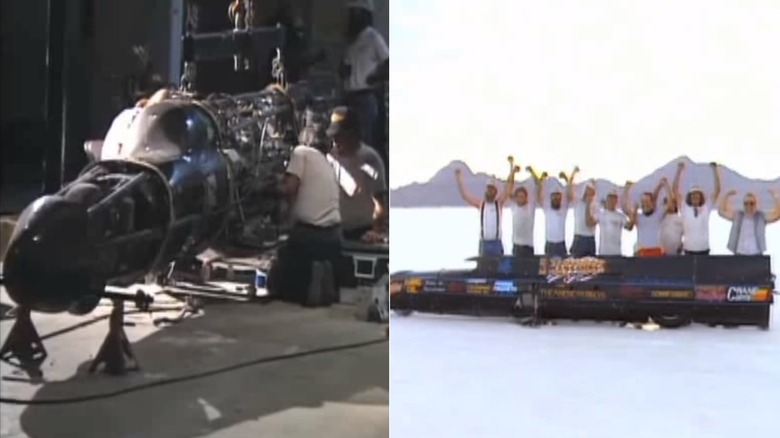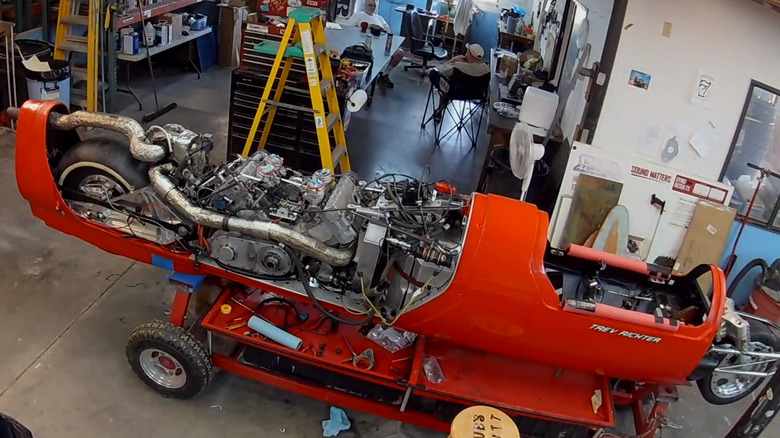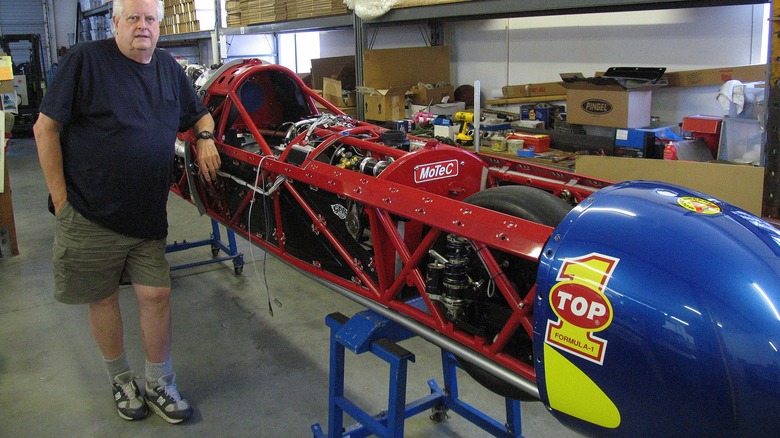12 Of The Fastest Motorcycles Ever Built
For as long as motorcycles have existed, riders have wanted to go faster on them. However, riding fast can mean a variety of things, including lap times, acceleration, or all-out top speed. Out of those, it's top speed that's the most easily comparable metric, and it's also what record adjudicators use to determine the motorcycle land speed record. Those record-breaking machines can reach speeds that far eclipse anything a production bike could achieve, but even hitting the top speeds of today's best superbikes will require a level of skill and bravery far beyond the average rider.
Measuring the top speed of the fastest production motorcycles is not an exact science –- some manufacturers choose not to publish top speed figures and not every officially published top speed aligns with what riders can expect to achieve in the real world. Nonetheless, these twelve motorcycles have proved to be among the fastest ever made, whether they're ready-to-order production bikes or one-off land speed record chasers.
Aprilia RSV4 Factory 1100 – 189 mph
Aprilia's latest RSV4 Factory is built first and foremost for high-speed track thrills, with a number of iterative improvements over previous generations to make it both faster and easier to ride. Its 1,099 cc V4 engine produces 217 horsepower at 13,000 rpm, while a new ECU helps lower emissions without compromising power. Aprilia claims the bike exceeds 189 mph but doesn't specify by how much. Owners have tested it on closed circuits and found it capable of reaching 200 mph, although this has not been officially verified.
The Aprilia is just one of the new breed of superbikes that gives track day enthusiasts more choice than ever -– assuming, that is, they have deep enough pockets. The RSV4 Factory starts from $25,999, making it a fair investment, albeit one that's about as close to a MotoGP Aprilia race bike as non-professionals are ever likely to get.
BMW M 1000 RR – 195 mph
As BMW's most expensive motorcycle and a bearer of the prestigious M badge, the M 1000 RR has a lot to live up to. It needs to deliver the performance expected of a flagship superbike, taking as much inspiration as possible from the brand's competition prototypes while still meeting the criteria to be road-legal. The 2023 model has more than delivered, with an increased top speed and close to 40% extra downforce over the outgoing model.
Its officially quoted top speed is 195 mph, an increase of 5 mph over the previous iteration. Much like the Aprilia RSV4 Factory, its performance will only be fully accessible to the most experienced riders on a closed circuit. They're also among the only riders that will be able to justify its price tag of $38,750. BMW's World Superbike experience means that the M 1000 RR is going to be extremely difficult to beat around a circuit, even if other rivals can top it in a straight line.
Damon HyperSport – 200 mph
While conventional gas-powered motorcycles continue to get faster and faster, a new group of upstart challengers is emerging that promise to take the top-speed race to even more death-defying heights. Electric motorcycles like the Damon HyperSport might still be in their infancy, but they're already claiming performance figures that compete with the industry's best. The HyperSport is officially claimed to reach 200 mph while — rather conveniently for its marketing team — also producing 200 horsepower and traveling a range of 200 miles.
Damon has proved its stats are more than just marketing though, releasing a video of the bike reaching 200 mph on a dyno in 2023. The top-spec HyperSport Premier is currently available to order for a 2024 delivery with a starting MSRP of $40,000. However, the cheaper HS trim also boasts the same 200 mph top speed and costs a slightly more attainable $28,000.
Ducati Panigale V4 R – 202 mph
The latest and greatest Ducati superbike is more powerful than ever, with up to 240.5 horsepower available in its track-only configuration. To reach that, the bike requires both an Akrapovič racing exhaust and proprietary Ducati Shell oil, but even in stock road-ready form, it'll still produce 207 horses at 13,500 rpm. Top speed is not officially published -– and will vary to some degree based on the bike's setup -– but a previous generation of the bike was reported to reach 202 mph. It's safe to say that the latest iteration should be able to achieve even higher figures.
Like all the superbikes here, the Panigale V4 R draws on Ducati's racing expertise in the MotoGP and World Superbike championships and is the closest production bike to the brand's racing prototypes. It starts at $45,495, but it's well worth the price of entry for serious track day enthusiasts.
Lightning LS-218 – 218 mph
One of the earliest production electric superbikes, the Lightning LS-218 might have been around for a few years now, but it's still one of the best EV motorcycles on the market. The company first set an average speed record at Bonneville of 216 mph back in 2011, with a top speed of 218 mph, hence the bike's name. Customer deliveries began in 2016 and although several variants have been released in the years since it's still the LS-218 that tops the performance charts.
Its electric motor produces 244 horsepower and can make the leap from 0 to 60 mph in just two seconds. The range isn't the greatest on the market, at 188 miles, but this is more of a showcase performance bike than anything else, so that's hardly a deal breaker. While it's not quite as expensive as the Ducati Panigale V4 R, the LS-218 is still in the same price bracket, at a starting MSRP of $38,988.
For now, it remains the world's fastest production electric motorcycle and one of the fastest road-legal motorcycles ever made.
Kawasaki Ninja H2R – 249 mph
While it's not street-legal, the Kawasaki Ninja H2R is the world's fastest production motorcycle tested on public roads. It was put to the test by professional racer Kenan Sofuoğlu in 2016, achieving a top speed of 249 mph and taking just 26 seconds to reach it. The feat was performed on a closed bridge in Turkey and used an unmodified bike borrowed from Kawasaki. It required some serious preparation, with the rider and his team working out the optimal conditions and time of day beforehand to ensure the safest run possible.
No one has tried to break the record since –- if nothing else, the logistics involved in finding a suitable public road would be a headache for even the most well-resourced of factory teams. Sofuoğlu's record took place two days before the new bridge opened to the public, making it an essentially unrepeatable opportunity, so it's unlikely that we'll see a challenger to the title anytime soon.
MTT 420-RR – 250 mph
The first generation of Marine Turbine Technology's Y2K bikes was conceived when a wealthy customer approached the company and asked it to develop a motorcycle that could harness the power of the brand's turbine engines. These early bikes boasted 320 horsepower and were certified on a dyno to a speed of 227 mph, but MTT recently unveiled its second-generation bike with an even more eye-watering power output. The new turbine produces 420 horsepower and more than 500 lb-ft of torque.
That makes it even faster -– so fast, in fact, that no one has dared to actually test its top speed yet. In an interview with BikeBound, MTT's founder claimed the latest bike's top speed would be somewhere north of 250 mph, but the team wasn't interested in finding out an exact figure since the bike started spinning its rear tire at 180 mph during a previous test run. So, for now, it remains a mystery exactly what the 420-RR can do, and it's unclear if we'll ever get a definitive answer.
Vesco Yamaha Silver Bird – 303 mph
While MTT's latest creation might be too fast for its founders to max out, it's not the fastest motorcycle ever built. In fact, a series of custom-built streamliner motorcycles have been certified as significantly faster, each one in pursuit of the overall motorcycle land speed record. The first motorcycle to break the 300 mph mark was the Yamaha-sponsored Silver Bird piloted by Don Vesco, which set a two-way record of 303.812 mph at the Bonneville Salt Flats in 1975. Several previous attempts by Vesco to break the record earlier in the year had ended in failure, with the streamliner losing stability and rolling onto its side at high speed.
Thankfully, Vesco escaped uninjured and went on to complete several more unsuccessful runs before finally cracking the 300 mph barrier. The motorcycle itself took a reported $60,000 to build and was powered by two TZ750 Yamaha engines. Vesco was already the record holder and the Silver Bird was simply an improvement over his previous motorcycle –- but it would turn out not to be his last.
[Featured image by Mat Guzzetta via Wikimedia Commons | Cropped and scaled | CC BY-SA 3.0]
Vesco Kawasaki Lightning Bolt – 318 mph
Don Vesco's enthusiasm for further record breaking caught the eye of Kawasaki, who sponsored his next streamliner motorcycle and provided two turbocharged 1,000 cc engines with a combined output of around 400 horsepower. The Lightning Bolt, which took its name after the clothing brand that sponsored it, first attempted the world record in the summer of 1978. However, like the Silver Bird before it, it took several tries before Vesco was successful.
A string of mechanical failures and problems with overheating saw reporters and TV crews that had been assembled by Kawasaki sent away after the first set of runs with no result. The biggest problem the team faced was that while the engines themselves were strong, the motorcycle components used elsewhere in the build couldn't handle the stresses. After multiple transmission and belt breakages, enough custom-upgraded parts were fabricated for another attempt. However, this was ruined by bad weather, and when it eased, another transmission failure dampened hopes of a new record.
It would take several weeks, but eventually, reporters were summoned once again, and Vesco completed a two-way run at 318.866 mph, beating his previous record by around 15 mph.
Easyriders Streamliner – 322 mph
Vesco's record would stand for another 12 years before Dave Campos took a streamliner sponsored by Easyriders magazine to 322.149 mph in July 1990. It was a risky endeavor –- at those speeds, the forces were so great that the handlebars were ripped from Campos' hands on an early run, causing him to crash and seriously damage the bike. A second crash caused by faulty wheels caused so much damage that it took the team three days to repair. The streamliner was also using 23-year-old Firestone tires, as they were the only tires with a high enough speed rating but hadn't been produced since 1967.
Power was provided by two Harley-Davidson 1,500cc engines, which formed a key part of the bike's appeal. Easyriders owner Joe Teresi cited the goal of bringing the record back to an American-powered bike as one of the main reasons he financed the program. However, he wasn't the only backer -– a significant portion of the backing came from the readers of Easyriders, who each paid $25 for the opportunity to have their names on the side of the bike.
BUB Seven – 367 mph
In the mid-'00s, competition for the record began to heat up again as two teams fought against each other and traded places for the crown over the course of several years. BUB Seven, piloted by Chris Carr, first broke the 350 mph barrier in 2006 and would continue improving on that speed until 2009, when he achieved a 367.382 mph two-way record. The design of the motorcycle came from an unlikely source: a nature documentary. Specifically, it was the shape of a salmon that inspired designer Denis Manning because he realized how fast it could swim through water without experiencing lift or drag.
His salmon-shaped streamliner was powered by a turbocharged 3,000cc V4 engine, which was custom-built for the record attempt. It produced around 500 horsepower at full throttle. Much like previous efforts, the Seven's development was delayed by a lack of available tires, but eventually, the team convinced Goodyear to develop custom tires for the bike.
Manning claimed at the time of the record that his next goal was to break the 400 mph barrier, but so far, that has proved elusive. However, that hasn't been through lack of trying, with the most recent efforts taking place in 2022 with a revised version of the motorcycle dubbed BUB 7.1.
Top 1 Oil Ack Attack – 376 mph
For now, the Guinness World Record holder for the fastest motorcycle ever made remains the Ack Attack sponsored by Top 1 Oil. Starting in 2006, the team battled against the speed set by BUB Seven, setting a record of 360 mph in 2008 before being beaten again shortly after. In September 2010, the Ack Attack streamliner ridden by Rocky Robinson clocked 376.363 mph average over two runs, topping out at 394 mph.
The streamliner packed two heavily modified Suzuki Hayabusa engines with twin turbos at 30 psi boost. Its exact power output isn't known but was reported to be somewhere between 700 and 900 horsepower. It used carbon fiber body panels to keep weight to a minimum. For now, it remains the fastest motorcycle ever built, with its thirteen-year record being one of the longest-standing to date.
[Featured image by Groensch via Wikimedia Commons | Cropped and scaled | CC BY-SA 4.0]
